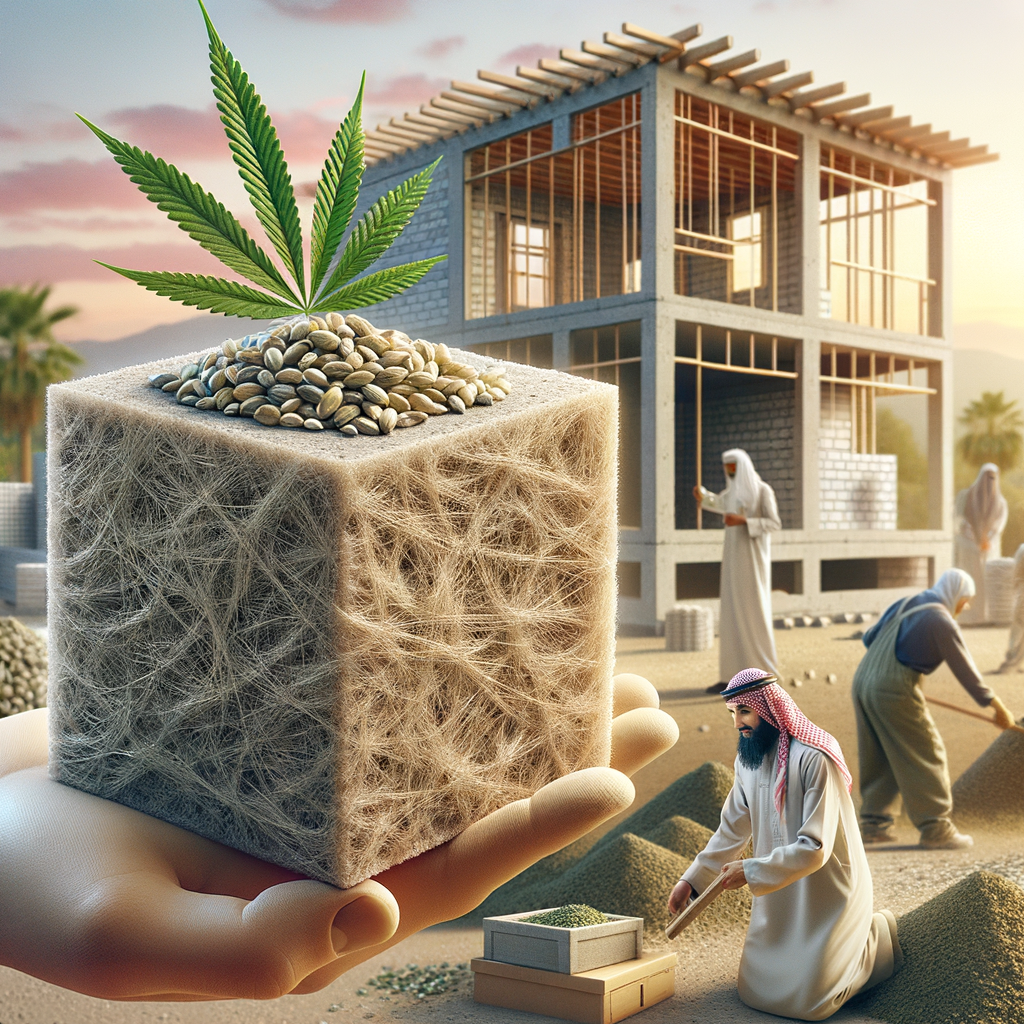
Hempcrete Building Material: The Sustainable Game-Changer
- What is Hempcrete?
- Benefits of Using Hempcrete
- Sustainability
- Energy Efficiency
- Durability and Maintenance
- How is Hempcrete Made?
- Essential Materials
- The Mixing Process
- Applications of Hempcrete
- Residential Construction
- Commercial Properties
- Innovative Designs
- Comparisons with Other Building Materials
- Hempcrete vs. Traditional Concrete
- Hempcrete vs. Timber
- Challenges in Using Hempcrete
- Limited Structural Capacity
- Regulatory Hurdles
- Awareness and Education
- The Future of Hempcrete
- Innovations in Hempcrete Technology
- Expanding Market Demand
- Conclusion
- FAQs
- References
What is Hempcrete?
Hempcrete is a bio-composite material made from hemp hurds (the woody inner part of the hemp plant), lime, and water. This unique blend creates a lightweight, sustainable building material ideal for eco-friendly construction. It’s not structural on its own, but it provides excellent insulation and is often used as infill in framed structures.
Unlike traditional concrete, hempcrete is breathable, allowing moisture to escape without harming the integrity of the walls. This quality enhances indoor air quality, making it an attractive option for sustainable building practices. Moreover, hemp grows quickly and requires fewer resources, which further contributes to its eco-friendly reputation.
As the interest in sustainable building materials grows, many builders and homeowners turn to hempcrete. With rising energy costs and environmental concerns, hempcrete offers a viable alternative that aligns with modern eco-conscious goals.
Benefits of Using Hempcrete
Sustainability
One of the standout benefits of hempcrete is its sustainability. Hemp can be cultivated in a variety of soils, and it doesn’t require harmful pesticides or herbicides. It also grows rapidly, providing a renewable resource that contributes to better agricultural practices.
Additionally, hemp absorbs CO2 during its growth cycle. This means that, in theory, building with hempcrete sequesters carbon dioxide, making it a carbon-negative option. By choosing hempcrete, builders actively participate in combating climate change.
Energy Efficiency
Hempcrete enhances energy efficiency significantly. The material offers excellent thermal insulation, which keeps indoor spaces warm in the winter and cool in the summer. This insulation reduces the need for heating and cooling, trimming energy bills in the long run.
Moreover, hempcrete walls help maintain a steady indoor temperature. Thus, they offer comfort and can even contribute to well-being. The energy-efficient properties make hempcrete an appealing option for homeowners looking to reduce their carbon footprint.
Durability and Maintenance
Hempcrete is surprisingly durable for a natural product. When mixed correctly, hempcrete can withstand decaying elements like mold and pests. Lime used in the mix also provides natural resistance to termites and other pests, which ensures longevity.
Hempcrete does require some maintenance, like any other building material. However, due to its resistance to mold and moisture, it often requires less maintenance than traditional building materials. This longevity translates to lower overall lifecycle costs, enhancing its desirability.
How is Hempcrete Made?
Creating hempcrete involves several straightforward steps. First, washing and drying the hemp hurds ensures they are ready for mixing. The dried hemp is then combined with lime and water to create a préformed paste.
Essential Materials
1. Hemp Hurds: The primary ingredient, providing insulation and structural integrity.
2. Lime: Offers strength and retains moisture, allowing for the breathability of the walls.
3. Water: Binds the components together and activates the lime.
The Mixing Process
The mixing process requires precision. The typical ratio is approximately 1 part lime to 3 parts hemp hurds by volume. Water is added carefully to achieve the desired consistency. This mixture must be homogeneous to function correctly.
Once mixed, the hempcrete can be poured into forms. Builders often use wood or metal frames to create the wall cavities. After pouring, it sets and hardens over time. Finally, a cured hempcrete wall demonstrates impressive properties, ready for any construction project.
Applications of Hempcrete
Hempcrete has various applications in construction, from residential buildings to commercial projects. Its versatility makes it suitable for new builds, renovations, and even eco-friendly landscape designs.
Residential Construction
Many modern homeowners opt for hempcrete when building energy-efficient homes. Its insulating properties keep homes comfortable year-round while minimizing energy expenditures. Builders often incorporate hempcrete into walls, floors, and roofs for maximum effectiveness.
Commercial Properties
Several businesses focus on environmentally friendly construction. The use of hempcrete in offices and retail spaces aligns with their sustainability goals. Commercial buildings designed with hempcrete can demonstrate their commitment to the environment, which attracts eco-conscious customers.
Innovative Designs
Hempcrete allows for creative architectural designs. Its flexibility in application means it can adapt to various structures. From sculptural forms to traditional styles, architects appreciate hempcrete’s adaptability.
Comparisons with Other Building Materials
When it comes to sustainable building, hempcrete stands out against traditional materials like wood and conventional concrete. Each building material has its unique benefits and drawbacks.
Hempcrete vs. Traditional Concrete
| Feature | Hempcrete | Traditional Concrete |
|——————|——————————|————————-|
| CO2 Emissions | Carbon-negative | Carbon-intensive |
| Insulation | Excellent thermal insulation | Poor insulation |
| Weight | Lightweight | Heavy |
| Durability | Resistant to mold & pests | Susceptible to cracking |
Hempcrete is more eco-friendly and offers better thermal performance. In contrast, traditional concrete provides structural strength but contributes to higher carbon emissions.
Hempcrete vs. Timber
| Feature | Hempcrete | Timber |
|——————|——————————|————————-|
| Sustainability | Highly sustainable | Can be sustainable (if sourced responsibly) |
| Durability | Resistant to mold & pests | Susceptible to rot |
| Insulation | Excellent | Moderate |
While timber can be a strong building material, it may not be as durable as hempcrete. Furthermore, the sourcing of timber can pose sustainability issues, while hemp is renewable.
Challenges in Using Hempcrete
Although hempcrete offers many advantages, navigating some challenges is essential. Awareness and understanding of these challenges can help builders make informed choices.
Limited Structural Capacity
Hempcrete does not stand alone as a structural material. Builders must use it in conjunction with other materials, such as wood or steel framing. This requirement may limit some design options. However, most architects and builders find ways to address this limitation through innovative designs.
Regulatory Hurdles
While hempcrete gains popularity, building codes often lag behind. Regulations differ significantly between regions. Builders may need to work closely with local authorities to determine compliance, which can slow down project timelines.
Awareness and Education
Many people are still unaware of hempcrete and its benefits. While its popularity is rising, builders and consumers need education about its properties and applications. Increased awareness can drive demand, encouraging more builders to incorporate this material into their projects.
The Future of Hempcrete
As sustainability becomes increasingly crucial in construction, hempcrete could take center stage. With a growing awareness of climate change, more builders and homeowners seek sustainable options. Hempcrete stands to benefit significantly from this shift in perspective.
Innovations in Hempcrete Technology
Recent advancements in building technology pave the way for the mass production of hempcrete. Research and development may lead to more efficient ways to create and apply this material. This innovation can lower costs and broaden the scope of hempcrete applications.
Expanding Market Demand
As people become more conscientious about their choices, the demand for eco-friendly building materials will likely continue to rise. Consequently, hempcrete may capture a more significant portion of the construction market. Increased acceptance and demand for hempcrete can encourage more manufacturers to enter the market.
Conclusion
Hempcrete represents an exciting shift in sustainable construction. Its array of benefits, including sustainability, energy efficiency, and durability, makes it a viable alternative to traditional building materials. While challenges exist, the future of hempcrete looks promising. As awareness and demand grow, this eco-friendly building material stands to redefine how we think about construction.
FAQs
1. What is hempcrete used for?
Hempcrete is used primarily for insulation within walls but can also serve in flooring and roof structures.
2. Is hempcrete fire-resistant?
Yes, hempcrete is naturally fire-resistant due to the lime content, which doesn’t ignite easily.
3. How long does hempcrete last?
With proper installation and maintenance, hempcrete can last several decades, often outperforming traditional materials.
4. Can hempcrete be recycled?
Yes, hempcrete is recyclable, making it an environmentally friendly choice for sustainable building.
5. What is the cost of building with hempcrete?
The price can vary based on location and project complexity. Generally, it is comparable to conventional building materials.
6. How does hempcrete affect indoor air quality?
Hempcrete is breathable, allowing for better moisture control and contributing to improved indoor air quality.
7. Is hempcrete mold-resistant?
Yes, the lime component in hempcrete protects against mold and some pest infestations.
8. Can I use hempcrete for load-bearing walls?
Hempcrete should not be used for load-bearing walls but rather as infill within structural frames.
9. Where can I buy hempcrete?
Hempcrete is available from specialized suppliers and manufacturers focusing on eco-friendly building materials.
10. Do I need special skills to work with hempcrete?
While it’s beneficial to have construction experience, many builders find working with hempcrete straightforward with the right training.
References
1. Hozjan, M., Cottam, C., & Jessop, G. (2021). Sustainable Building with Hempcrete. Retrieved from BuildingGreen.
2. Van de Walle, S., & Deschamps, P. (2020). Architectural possibilities of hemp-based materials. Retrieved from Journal of Clean Production.
3. VTA Studio. (2019). The properties of hempcrete: A new construction material. Retrieved from VTA Studio.

